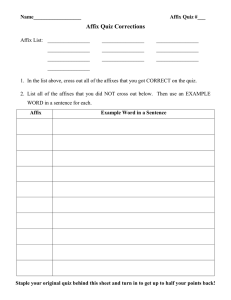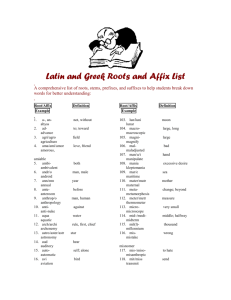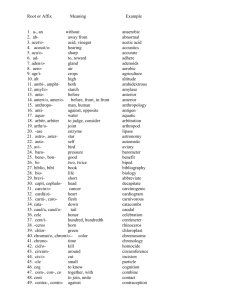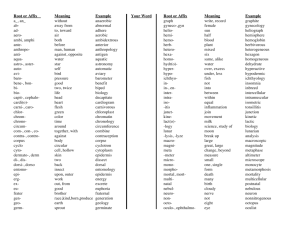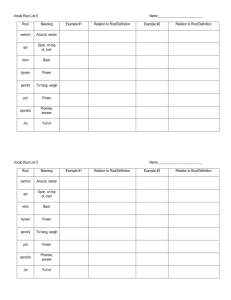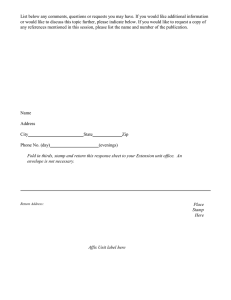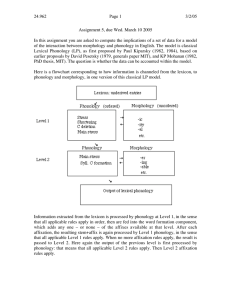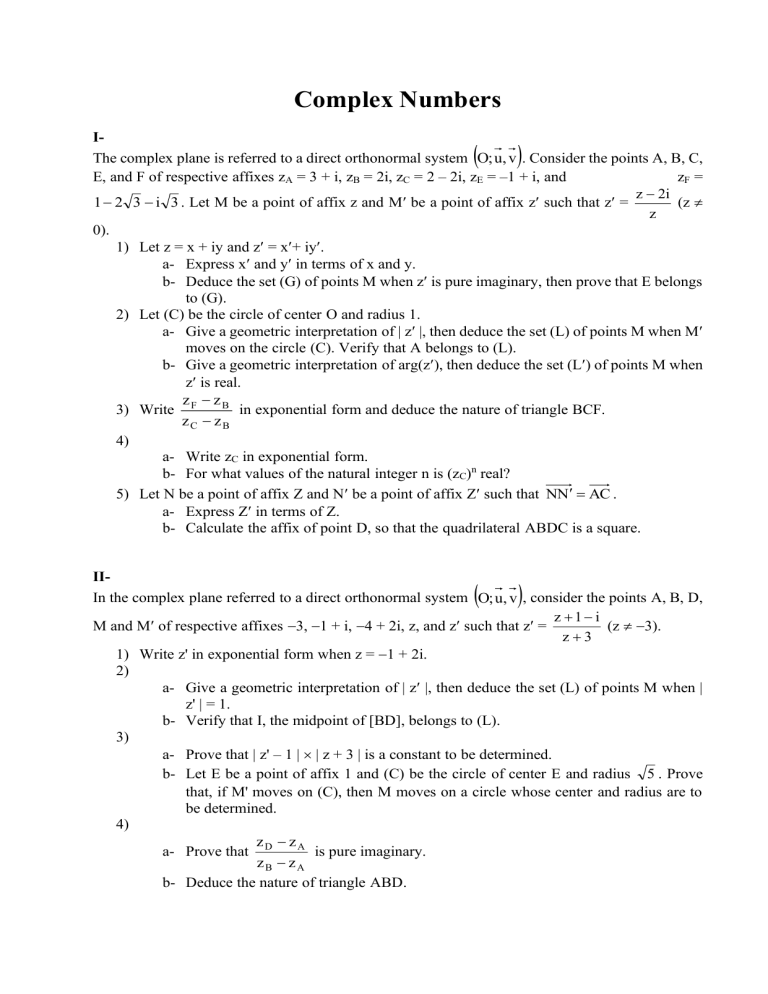
Complex Numbers IThe complex plane is referred to a direct orthonormal system O; u, v . Consider the points A, B, C, E, and F of respective affixes zA = 3 + i, zB = 2i, zC = 2 – 2i, zE = –1 + i, and zF = z − 2i (z 1 − 2 3 − i 3 . Let M be a point of affix z and M be a point of affix z such that z = z 0). 1) Let z = x + iy and z = x+ iy. a- Express x and y in terms of x and y. b- Deduce the set (G) of points M when z is pure imaginary, then prove that E belongs to (G). 2) Let (C) be the circle of center O and radius 1. a- Give a geometric interpretation of | z |, then deduce the set (L) of points M when M moves on the circle (C). Verify that A belongs to (L). b- Give a geometric interpretation of arg(z), then deduce the set (L) of points M when z is real. zF − zB 3) Write in exponential form and deduce the nature of triangle BCF. zC − zB 4) a- Write zC in exponential form. b- For what values of the natural integer n is (zC)n real? 5) Let N be a point of affix Z and N be a point of affix Z such that NN = AC . a- Express Z in terms of Z. b- Calculate the affix of point D, so that the quadrilateral ABDC is a square. ( ) IIIn the complex plane referred to a direct orthonormal system O; u, v , consider the points A, B, D, z +1− i M and M of respective affixes −3, −1 + i, −4 + 2i, z, and z such that z = (z −3). z+3 1) Write z' in exponential form when z = −1 + 2i. 2) a- Give a geometric interpretation of | z |, then deduce the set (L) of points M when | z' | = 1. b- Verify that I, the midpoint of [BD], belongs to (L). 3) a- Prove that | z' – 1 | | z + 3 | is a constant to be determined. b- Let E be a point of affix 1 and (C) be the circle of center E and radius 5 . Prove that, if M' moves on (C), then M moves on a circle whose center and radius are to be determined. 4) z − zA a- Prove that D is pure imaginary. zB − zA b- Deduce the nature of triangle ABD. ( ) III- → → In the complex plane referred to a direct orthonormal system O; u , v , consider the points M1, M2, M3, and M4 of respective affixes: 3+i z1 = , z2 = z1 – i, z3 = z 1 − 1 , and z4 = eiθ. 4 1) a- Determine the algebraic forms of z2 and z3. b- Calculate the modulus and an argument of z1 and those of z2. 2) a- Calculate | z3 – z2 | and | z3 – z1 |. Deduce that the triangle M1M2M3 is isosceles. b- Verify that the triangle OM1M2 is right. 3) a- Write z = z12z22 in algebraic and exponential form. b- Find θ, so that zz4 is real. 4) Consider the point M of affix z (z 0 and z 1) and the point M of affix z = 1 + z2. Let A z2 be the point of affix 1 and U be the complex number such that U = . z −1 z − 1 a- Define, geometrically, arg . z −1 b- Deduce that U is real when the points A, M, and M are collinear. Construct M and M when U = 2. c- Find the set of points M so that AM2 = AM. IV- → → The plane is referred to a direct orthonormal system O; u , v . Let A be the point of affix −2i. For every point M of affix z, we associate the point M of affix z where z = − 2z + 2i . 1) Consider the point B of affix b = 3 − 2i. Determine the algebraic forms of a and b, the associated affixes of points A and B respectively. 2) Prove that, for every point M of affix z, | z + 2i | = 2 | z + 2i |. Interpret this result geometrically. 3) For every point M distinct from A, we call an argument of z + 2i. a- Give a geometric interpretation of . b- Show that (z + 2i)(z + 2i) is a negative or null real number. c- Deduce, in terms of , an argument of z + 2i. VIn the complex plane of a direct orthonormal system O; u, v , consider the point M of affix z. 2iz − i For every complex number z -1, we associate the complex number Z such that Z = . z +1 1) Let z = x + iy, where x and y are real numbers. Calculate Z , Re(Z), Im(Z), and | Z | in terms of x and y. 2) Find the set of points M such that | Z | = 1. 3) Find the set of points M such that Z is pure imaginary. VI → → In the complex plane referred to a direct orthonormal system O, u, v , consider the points A and B of affixes −1 and −i respectively. M being a point in the plane, of affix z (M is distinct from A), − iz − 2 consider the point M´ of affix z´ such that: z´ = . z +1 ( ) −i 1) Write z´ in its algebraic form in the case where z = 2e 4 . 2) Let z = x + iy and z´ = x´ + iy´. a- Express x´ and y´ in terms of x and y. b- What is the set of points M when z' is a real number? 3) a- Calculate z´ + i in terms of z. What can you say about | z´ + i | | z + 1 |? b- Suppose that M moves on a circle (C) of center A and radius 2. Show that M´ moves on a circle (C´) whose center and radius are to determined. VII- (4 points) In the complex plane referred to a direct orthonormal system O; u, v , consider the point A of affix 1, the point B of affix i, the circle (C) of center O and radius 1, and the straight-line (D) of z−i equation y = 1. M is a point of affix z (z i) and M' is a point of affix z' such that z' = . z+i ( − i 2e 6 . ) 1) Write z' in its algebraic form when z = 2) Determine the set of points M when z' = 1. 3) Prove that z z = 1 .Give a geometric interpretation of this result. 4) z '−1 a- Prove that is pure imaginary. Deduce that the two straight-lines (AM') and z−i (BM) are perpendicular. b- M is a point that does not belong to (D). Construct, geometrically, the point M'. c- Specify the position of point M' when point M belongs to the straight-line (D) deprived of point B. VIIIPart A ( ) In the complex plane of a direct orthonormal system O; u, v , consider the point M of affix z. 2iz − i For every complex number z -1, we associate the complex number Z such that Z = . Let z +1 z = x + iy, where x and y are real numbers. 1) Calculate Z , Re(Z), Im(Z), and | Z | in terms of x and y. 2) Find the set of points M such that | Z | = 1. 3) Find the set of points M such that Z is pure imaginary. Part B 1) Place, in the complex plane of a direct orthonormal system O; u, v , the points A, B, C, ( ) and D of respective affixes z A = i 3 , z B = −i 3 , z C = 3 + 2i 3 , and z D = z C . 2) a- Prove that A, B, C, and D belong to the same circle. b- Let E be the symmetric of D with respect to O. Prove that −i zC − zB =e 3. zE − zB c- Determine the nature of triangle of BEC. IXIn the complex plane referred to a direct orthonormal system O; u, v , consider the points M of − 1 + 2i affix z (z 2) and M' of affix z' such that z = . z−2 1+ i 1) Find the exponential form of z' when z = . 2 2) Prove that: If M' moves on the circle of center O and radius 1, then M moves on a circle whose radius and center are to be determined. 3) Let z = x + iy. Find the set of the points M when z' is a real number. ( ) X- z1 3 − z 2 = −2 1) Let z1 and z2 be two complex numbers such that . Find z1 and z2. z1 − z 2 3 = −2i ( ) 2) In the complex plane of a direct orthonormal system O; u, v (unit: 2 cm), consider the points A and B of respective affixes: zA = − 3 + i and zB = − 1+ i 3 . Write zA and zB in the exponential form, then place the points A and B. 3) a- Calculate the modulus and the argument of zA . zB ( ) b- Deduce the nature of triangle ABO and give a measure of angle OA; OB . 4) Determine the affix of point C such that the quadrilateral ACBO is a rhombus. Place C, then calculate the area of triangle ABC in cm2. z1 in the trigonometric and exponential forms. z2 z 2) Determine the algebraic form of 1 . z2 1) Write z1, z2, and 3) Deduce that: cos = 12 6+ 2 = and sin 4 12 6− 2 . 4 XIIn the table below only one, among the proposed answers to each question, is correct. Write down the number of each question and give, with justification, the corresponding answer. A B C The exponential form of z 1) 2e( − )i 2e−i 2e( + )i = −2ei is If the exponential form of z is 11 i 2e 12 and its algebraic 2) −1− 3 3 −1 + i, form is 2 2 then z = (− 1 + i )(2 sin + 2i cos ) . 3 −i 3) |z|= z = (− 1 + i )(2 sin + 2i cos ) . 3 −i 4) An argument of z is 3 +1 cos = 12 2 2 sin = 3 − 1 12 2 2 11 = cos 12 sin 11 = 12 2 2 − 3 +1 2 2 3 −1 2 2 11 − 1 − 3 = cos 12 2 sin 11 = 3 − 1 12 2 None 2 7 + 12 11 + 12 7 − 12 XII- ( ) In the complex plane referred to a direct orthonormal system O; u, v , consider the points A, I, and B of respective affixes 1, 2, and 3. M being a point in the plane of affix z (M is distinct from I), consider the point M of affix z 1 +2. such that z = z−2 1) Determine the points M so that M and M are confounded. 2) → → a- Calculate, in terms of z, the affixes of the vectors IM and IM . b- Deduce a relation between IM and IM, then a relation between the angles → → → → u , IM and u , IM . i 3 c- Place the point M0 of affix z0 = 2 + 2 e in the plane, then the point M0 using the preceding part. 3) Suppose that M is a point in the plane different from A and B. a- Calculate z − 1 and z − 3 in terms of z. b- Verify that 1 − z 1− z . =− 3 − z 3−z M A MA and , then a relation between the angles M B MB → → → → M B, M A and MB, MA . d- Prove that, if M belongs to the perpendicular bisector of [AB], then M belongs to the perpendicular bisector of [AB]. c- Deduce a relation between XIII ( ) 1) In the complex plane referred to a direct orthonormal system O; u, v , consider the 1+ i complex number z = . 1− i 3 a- Determine the modulus and an argument of z. b- For what values of the non-zero natural number n is zn real? Calculate the smallest value of n. 2) Linearize cos3x. 3 1 3) Write z = − + i 2 2 2000 in its trigonometric form.
